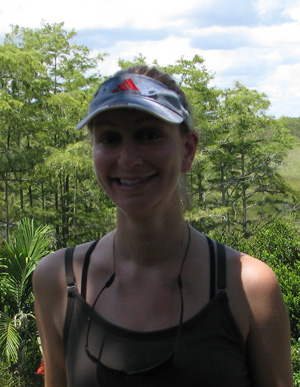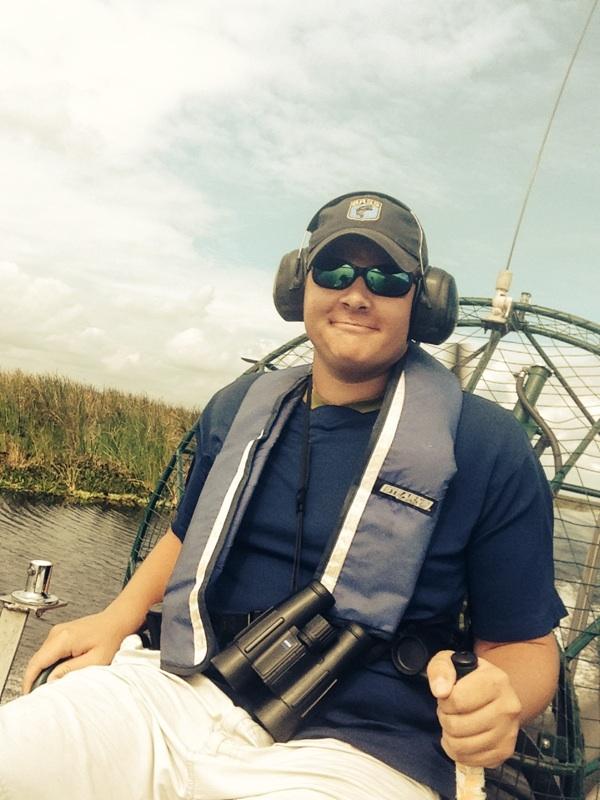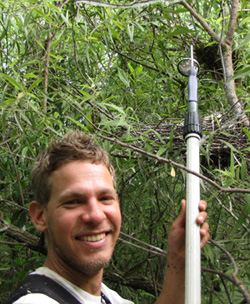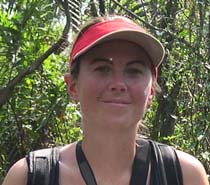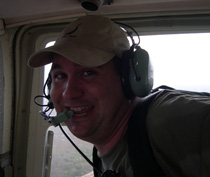| Jennifer Chastant PhD May 2016 | |
I’m originally from Atlanta, Georgia and I received a Bachelor’s degree in Biological Science from the University of Georgia in December of 2002. After graduation, I began working temporary field jobs all over the U.S. My initial love for birds began on Cumberland Island National Seashore, where I assisted a graduate student with the collection of nesting activity and behavioral data of American oystercatchers. After three years of working on other people’s projects, I decided I was ready for a research project of my own and began working on my Master’s in Wildlife Ecology at Mississippi State University. The project was designed to investigate population dynamics of Interior of Double-crested Cormorants throughout the Great Lakes region. After receiving my Master’s in 2008, I began working for the U.S. Fish & Wildlife Service and quickly realized that although management is extremely important, I missed the research aspect of the field. In Dr. Gawlik’s lab, I did my PhD research on wading bird responses to stress. Jennifer is currently an environmental scientist with Palm Beach County Environmental Resources Management. |
|
| Jessica Klassen PhD May 2016 | |
I received my B.S. in Ecology, Evolution, and Behavior at the University of Minnesota, Twin Cities in 2007. As an undergraduate, I took advantage of a study abroad program in which I studied the burrow characteristics of nesting Atlantic Puffins in the Vestmannaeyjar Islands off the southern coast of Iceland. My interest in avian ecology grew after participating in several research projects ranging from mallard population counts to raptor banding. After graduation, I took a field job researching the population and distribution of the endangered Golden-cheeked Warbler in central Texas. I was able to continue this research as a master’s student at Texas A&M University where my thesis focused on habitat characteristics affecting Golden-cheeked Warbler reproductive success. I joined the Gawlik lab in 2011 as a Ph.D. student working on the dry season prey concentration project. For my dissertation, I used landscape modeling techniques to make predictive models for aquatic prey concentration and body condition. I also researched wading bird prey selection in relation to hydrologic change. Jessica is currently a Lecturer in the Department of Wildlife and Fisheries Sciences at Texas A&M University. |
|
| Corey Callaghan MS August 2015 | |
I grew up in a small town in Western New York and have always been enthralled in the outdoors. I received a B.S. in Environmental Sciences and Mathematics in 2013 from Canisius College located in Buffalo, NY. Through my undergraduate studies I became enveloped in birds and birding. I then did undergraduate research focusing on nocturnal flight-calling behavior of warblers. I have conducted bird surveys as a biological technician for the USFWS and the Rocky Mountain Bird Observatory. My experiences and avid interest in birds led me to Dr. Gawlik’s lab, where I look forward to the opportunities that lie ahead. I received my Masters in Environmental Science from FAU in August 2015. For my thesis, I studied the Purple Swamphen and conducted the first formal study on the species in North America. I analyzed their diet contents and investigated for any selectivity they may be showing. I also used a modelling approach to investigate how/if exotic birds spread from urban to natural areas. |
|
| Brian Botson MS December 2012 | |
I received my B. S. in Wildlife Fisheries Science from Pennsylvania State University in 2001. Since 1999, I have worked for various organizations across the United States on a diverse array of wildlife research projects with fish, birds, mammals and plants. As the research coordinator for Dr. Dale Gawlik’s lab at Florida Atlantic University from 2004 through 2015, I collaborated with research staff and students to collect and manage data on wading birds, fish and aquatic invertebrates and the hydrologic and habitat structure characteristics influencing their populations. My main focus was the Aquatic Fauna Seasonal Concentration Project, a long term study under the Monitoring and Assessment Plan for the Everglades restoration. In this project, we attempted to discern the relationship among hydrology, prey concentrations and wading bird nesting by assessing prey concentrations throughout the Everglades landscape during the dry season and comparing prey concentrations between used and random sites. I completed my Master's thesis in December 2012, where I identified specific mechanisms responsible for transforming wet season prey standing stock into dry season prey concentrations, linked landscape hydrological patterns to wading bird nesting, and presented a predictive model of Wood Stork nesting. Brian is currently an Environmental Analyst at Harbor Branch Oceanographic Institute. |
|
| Leonardo Calle MS May 2014 | |
I got introduced to ecology in 2005 after reading Alan Beck's book on the "Ecology of Stray Dogs". Beck's research focused on the impact of stray dog populations on public health. He investigated, successfully, relationships between the distribution and abundance of stray dogs in Baltimore, socioeconomics, trash pick-up days, nutrient distribution, and rodents. I found his observations to be incredibly keen and creative, and they were what had initially inspired my pursuit of ecology. I returned to college in 2006, and shortly thereafter, in 2008, I volunteered as a field technician in the Avian Ecology Laboratory. My first real experience in ecology was flying in a helicopter to remote parts of the Everglades. I was hooked. The folks in the lab, and Dr. Gawlik, have been incredibly supportive and great mentors. I have been with the lab since that time, and I have involved myself in a variety of research projects and ecology education outreach programs. I am also proud to say that I am part of the Ecological Society of America's SEEDS program and the SEEDS chapter at FAU. Leo is currently pursuing a Ph.D. at Montana State University. |
|
| Richard Botta MS May 2014 | |
Although I acquired interests in my surrounding natural environment at an early age, I have not academically approached it until recently. Initially, I received my B.B.A. in International Business and Trade from FAU in 2007. As I completed this degree, I realized my true interests were elsewhere. As a young boy I spent much time outdoors, both here in the states, and in Argentina. Many days were spent with the wilderness as my playground. With this in mind, I returned to FAU to gain the tools I needed for a career in the environmental sciences. After taking classes in the disciplines of Ecology and GIS, I volunteered in the Avian Ecology Lab here at FAU with a large scale project studying aquatic prey concentrations for wading birds in the Everglades. This only opened my appetite for research in these fields, and this lead to becoming a technician for the Fauna Concentration Project. Afterwards, I aided as a technician for a project with avian communities in the Stormwater Treatment Areas in the Northern Everglades. I received my M.S. in Environmental Sciences from FAU in May 2014. For my thesis, I used environmental factors, including vegetation and hydrology to create a habitat suitability model for wading birds in Lake Okeechobee and validated the model using Lake Okeechobee nest effort data. Rich is currently an Environmental Scientist with the South Florida Water Management District. |
|
| Tyler Beck MS August 2013 | |
Being the son of a high school Biology teacher I have always been interested in natural things. Having lived in Central, Southwest and Southeast Florida I feel a deep connection with the region and its fragile ecosystems. I received a Bachelor’s degree from Florida Gulf Coast University in 2003. My undergraduate research focused on stand densities preferred by the Melaleuca Snout Weevil (Oxyops vitiosa), a controlling agent on the invasive Melaleuca Tree (Melaleuca quinquenervia). After graduation I volunteered with photographer Clyde Butcher assisting him with his Labor Day swamp walks. I later traveled to Pennsylvania to learn how to mist net and band passerines. In 2006, I interned with the Avian Ecology Lab at Archbold Biological Station in Lake Placid, Florida. My main responsibilities were to collect data for an ongoing (1969-present) demographic study of the cooperatively breeding Florida Scrub-Jay (Aphelocoma coerulescens). My independent research examined differences in the reproductive investment of scrub-jays that occupied different quality habitats. Shortly after my internship, I joined the Gawlik lab working on wading bird habitat selection and reproductive physiology projects. I received my M.S. in Biology from FAU in August of 2013. For my thesis work, I examined factors that influence avian community composition of Stormwater Treatment Areas in the Northern Everglades. Tyler is currently a biologist with the Florida Fish and Wildlife Conservation Commission. |
Rebecca Stanek MS May 2008 |
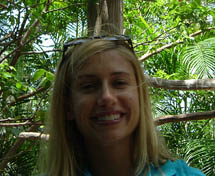 |
Upon graduation from State University of New York at Buffalo , I received a B.S. in Environmental Studies. Shortly thereafter, I attended Buffalo State College and completed a second B.S. in Biology. As the Assistant Animal Programs Manager at the Palm Beach Zoo in West Palm Beach , I specialize in the management of our animal diet and nutrition program. I also assist in the development of the Palm Beach Zoo's in-situ and ex-situ animal conservation involvement. I graduated with my M.S. in Biological Science in 2009. For my thesis research I used small-scale manipulative experiments to examine the effects of prey density and the presence of conspecifics on the foraging behavior of the Scarlet Ibis. Rebecca is currently an Education Manager with the Palm Beach County school system. |
James M. Beerens MS May 2008 |
|
|
I received my B.S. in Zoology at Michigan State University in 2003, concentrating in Animal Behavior and Neurobiology. After dabbling in the neurology of rats, I moved to Naples, FL to work for the Conservancy of Southwest Florida. There, I had many opportunities to be involved in research relating to Everglades restoration. This experience was followed by a behavioral ecology study of piscivorous birds on the Columbia River in Washington. After extended travel in South America, I settled back in Florida working in Key Largo with the endangered Key Largo Woodrat. My background is mostly in behavioral ecology and conservation. I am interested in the ecology of fragile ecosystems and the human responsibility to make educated decisions on how to manage those ecosystems under increasing threats. I received my M.S. in Biology from FAU in December of 2008. My thesis research examined the influence of food availability on landscape-level habitat selection, patch-level habitat selection, and movements of two wading bird species with divergent foraging strategies, the Great Egret and White Ibis. James is currently an ecologist with the U.S. Geological Survey.
|
| Garth Herring PhD May 2008
|
My academic background began over 10 years ago when I completed a diploma in Fisheries and Wildlife management from Sir Sanford Fleming College (Ontario, Canada). I then worked for six years conducting waterfowl research as a research technician across Canada and the United States for various state, federal and private conservation agencies. In 1997, I returned to school to obtain my Bachelors of Science at the University of Lethbridge (Alberta, Canada). I then started my Masters of Fisheries and Wildlife Science at North Carolina State University (Raleigh, North Carolina) in 2000. My Masters research focused on examining the quality of winter habitat for waterfowl in east-central Florida, in particular investigating movements and home range use, period specific survival, and foraging behavior and subsequent nutrient reserve dynamics of Lesser Scaup. Throughout this time my focus has always been to better my understanding of the ecological systems that I have had the opportunity to work in, while striving to increase the understanding of how humans have impacted these systems, and how we might mitigate these changes. Most recently I worked on a PhD. in Biological Sciences at Florida Atlantic University, where my research focused on how prey availability influences the physiological condition of wading birds and how their condition affects reproductive performance. Ultimately, this information can be used to influence restoration targets and management decisions. Garth is currently an ecologist with the U.S. Geological Survey.
|
Samantha Lantz MS May 2008
|
I began working in the Gawlik lab at FAU in the spring of 2006 as a technician for the fauna concentration project. From there I transitioned into a pilot study for my masters work, and started my MS officially in the fall of 2006. My research focused on the factors affecting wading bird prey availability, quantified by both foraging habitat selection and foraging success. I conducted a large-scale experiment as part of the Loxahatchee Impoundment Landscape Assessment (LILA) project where I manipulated prey density, vegetation, and water depth while looking at the response of a number of different wading bird species. More information about the LILA project and my results can be found by clicking here. My primary research interests are in behavioral ecology and conservation. Prior to coming to FAU, I graduated from Willamette University in Salem, OR in 2005 with a BA in biology. Most of my previous field work has involved work with seabirds and shorebirds along both the Pacific and Atlantic coasts, concentrating on foraging and reproductive success. For my thesis, I examinded the effects of water depth and emergent and submerged vegetation on wading bird habitat selection and foraging success. Samantha is currently pursuing her Ph.D. at Tulane University. |
Philip Heidemann MS May 2008  |
I graduated from Grinnell College in Iowa with a B.A. in Economics. Until last year, I spent most of my working life in finance and insurance. I worked in various capacities in the Accounts Payable Department at the world headquarters of Office Depot, Inc. here in Florida. I also endured a difficult six-year career in insurance, advancing finally to the position of Manager within the Claims Department of a Florida workers' compensation insurer. It was during my time in workers' compensation that I realized I was in the wrong field. After some self-evaluation, I determined that based on my interests I was most suited to a career in the biological sciences. I left my job and returned to school at FAU in the 2004-05 school year. I have now been admitted as a graduate student and will begin my M.S. in Biological Sciences program in fall 2005. I have recently worked on a study of the two crayfish species found in the Everglades, Procambarus alleni and P. fallax . This involved identifying samples by species and gender, and examining differences in spatial distribution, relative abundance, and habitat. My thesis research is to develop a Landscape Suitability Index for wood storks and white ibis in southwestern Florida. *Postscript - Tragically, Damion Marx along the Phillip Heidemann and Gareth Ackerman were killed in a plane crash while surveying wading birds. They are missed greatly. |
| Damion Marx PhD May 2008 | I received my B.S. from the Department of Biology at the University of Oregon in 1997. My undergraduate thesis compared the diversity of lady beetles ( Coccinellidae ) among native and non-native trees on the university campus. My first job out of college was with the National Audubon Society at the Corkscrew Swamp Sanctuary. There I was bitten by the “birding bug,” and since then, pursued a career in avian ecology. After several field experiences around the country, I attended Texas A&M University where I examined the response of wintering grassland birds to fire and grazing in Texas Coastal Prairies. I received my Masters from the Department of Wildlife and Fisheries Sciences in 2003. *Postscript - Tragically, Damion Marx along the Phillip Heidemann and Gareth Ackerman were killed in a plane crash while surveying wading birds. They are missed greatly. |
Heidi Herring MS December 2007
|
I received my Bachelor of Science in Wildlife, Fisheries, and Conservation Biology from the University of California, Davis in 1999. For my thesis research at FAU, I studied linkages between nesting colonies and foraging areas for wood storks (Mycteria americana) in Everglades National Park. I am a life-long birder and have been involved in avian research studies for 8 years. I have worked with several species of waterfowl, studying wood duck reproductive success in the central valley of northern California and the ecology of wintering lesser scaup in Florida . In 2000 and 2001, I banded passerines for the Ventana Wilderness Society at the Big Sur Ornithological Laboratory and for the Point Reyes Bird Observatory on the Eastern Sierra Riparian Songbird Project. Most recently, I worked as a biologist for a wetland environmental consulting firm where I conducted surveys for many special status wildlife species and implemented monitoring programs. I graduated from FAU with a M.S. in Biology in December of 2007. For my thesis, I developed a foraging habitat selection model for breeding Wood Storks in Everglades National Park. Heidi is currently a faculty member at Lynn-Benton Community College, Albany, OR.
|
Brian Garrett MS December 2007
|
I graduated from the University of Georgia in 1997 with a B.S. in Ecology and a minor in Botany. During my time at UGA I also interned at the Tate's Hell Swamp Field Site in Apalachicola, Florida. There I assisted several researchers working on projects that were leading towards the restoration of Tate's Hell Swamp. I also worked on my own project in Tate's Hell comparing the utility of two vegetative sampling methods in wet prairies. In 1997 I began working in the Everglades Division at the South Florida Water Management District. I work primarily in the Stormwater Treatment Area or STA discharge areas in the Northern Everglades. I work on projects that include water quality sampling, soil sampling, macrophyte surveys and sampling, periphyton sampling, aquatic macrofaunal surveys, and tree island monitoring. I have also conducted and assisted with several wildlife surveys within the Everglades. I manage several sets of data as well as several ongoing experiments. I graduated from FAU with a M.S. in Biology in December of 2007. My thesis research focused on modeling hydrologic and physical factors that affect the concentration of wading bird prey during the dry season. I created a simulation model that displays the potential effects of different levels of microtopography upon prey concentrations during the annual hydrologic dry down in the Everglades marsh. Brian is currently a Wildlife Coordinator with the South Florida Water Management District. |
Rachael Harris MS May 2007
|
I graduated from Michigan State University in 2001 with a BS in Zoology and Environmental Biology. After graduation, I worked for several years as a technician on various projects in Michigan . My background is mostly in aquatic entomology and ichthyology. I am interested in the ecology of aquatic ecosystems, predator-prey relationships, and foodweb dynamics. I began working on my MS at Florida Atlantic University in 2004. I graduated from FAU with a M.S. in Biology in May of 2007. My thesis work tested prey vulnerability components of the wading bird prey availability model. Treatment variables included vegetation structure and prey density. Rachael is currently a Biologist with the Michigan Department of Natural Resources. |
| Technicians | |
|
Jenna May - Biological Technician 2014-Aquatic Seasonal Fauna Concentrations Rachael Fern- Biological Technician 2014-Wading Bird Colonies at Lake Okeechobee Nicole Hengst- Biological Technician 2014-Wading Bird Colonies at Lake Okeechobee Sarah Bornhoeft - Biological Technician 2013-Aquatic Seasonal Fauna Concentrations Megan Dillon- Biological Technician 2013-Wading Bird Colonies at Lake Okeechobee Elizabeth Dancer - Biological Technician 2012/2013-Wading Bird Colonies at Lake Okeechobee Kristin Norris - Biological Technician 2012-Wading Bird Colonies at Lake Okeechobee Christopher Malinowski - Biological Technician 2012-Aquatic Seasonal Fauna Concentrations Justin Michaud - Biological Technician 2011-Wading Bird Colonies at Lake Okeechobee Kristina Herz - Biological Technician 2010-Aquatic Seasonal Fauna Concentrations Rosemary Hartman - Biological Technician 2010-Wading Bird Colonies at Lake Okeechobee Daniel Hollenbaugh - Biological Technician 2009-2011-Avian Communities of the STAs/Aquatic Seasonal Fauna Concentration Joseph Serio - Biological Technician 2009-Aquatic Seasonal Fauna Concentrations Bridie Farmer - Field Crew Leader 2009/2010-Aquatic Seasonal Fauna Concentrations Justin Bredlau- Biological Technician 2009-Wading Bird Colonies at Lake Okeechobee William Bessmer- Biological Technician 2009-Aquatic Seasonal Fauna Concentrations Richard Botta - Biological Technician 2008-Aquatic Seasonal Fauna Concentrations Leonardo Calle - Biological Technician 2008/2011-Aquatic Seasonal Fauna Concentrations Claudia McLeroy - Biological Technician 2008-Aquatic Seasonal Fauna Concentrations Katherine Becker - Biological Technician 2008 - Avian Communities of the STAs Angela Sjollema - Biological Technician 2007 - LILA Meghan Weaver - Biological Technician 2007 & 2008 -Aquatic Seasonal Fauna Concentrations Kelly McKean - Biological Technician 2008-Aquatic Seasonal Fauna Concentrations Gareth Ackerman- Biological Technician 2008 - Wading Bird Colonies at Lake Okeechobee *Postscript - Tragically, Damion Marx along the Phillip Heidemann and Gareth Ackerman were killed in a plane crash while surveying wading birds. They are missed greatly. Tyler Beck - Biological Technician 2007 - Wading Bird Habitat Use Nina Hill - Biological Technician 2007 - Wading Bird Reproductive Physiology Juliet Lamb - Biological Technician 2007 - LILA Frank Marenghi - Biological Technician 2007 - Wading Bird Colonies at Lake Okeechobee Sarah Ridgway - Biological Technician 2007 -Aquatic Seasonal Fauna Concentrations Alegra Galle - Biological Technician 2006 - Wading Bird Colonies at Lake Okeechobee Andrew Horton - Biological Technician 2006 - Wading Bird Habitat Use Rebecca Imdieke - Biological Technician 2006 - Wading Bird Reproductive Physiology Sam Lantz - Biological Technician 2006 -Aquatic Seasonal Fauna Concentrations Kristen Simpson - Biological Technician 2006 -Aquatic Seasonal Fauna Concentrations Mark Johnston - Biological Technician 2005 Jennifer Nagy - Biological Technician 2005
|
|
Past Students & Technicians
Page Designed by Bryan Botson
Contact bbotson@fau.edu
Last updated Augusty 02, 2014
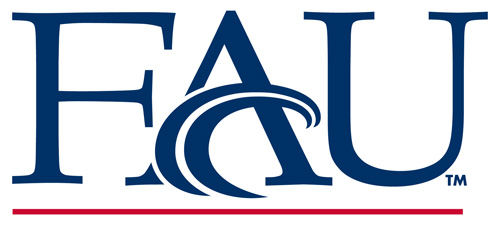
(c) Florida Atlantic University All rights reserved
